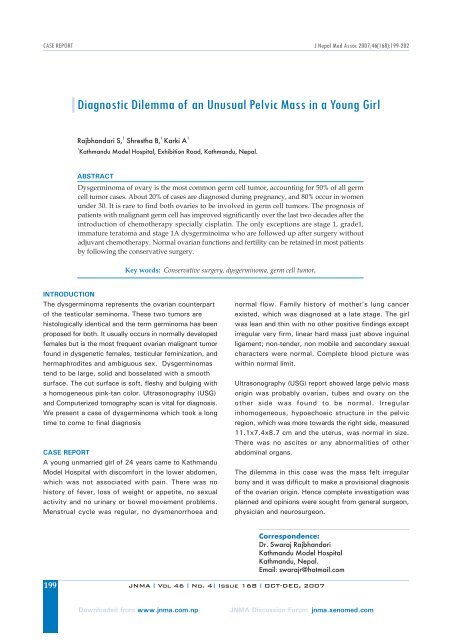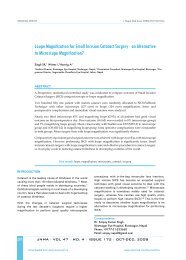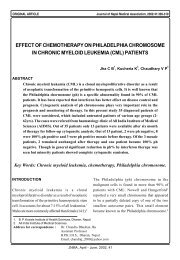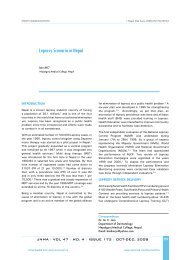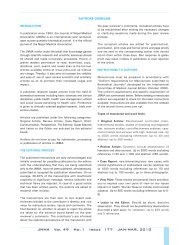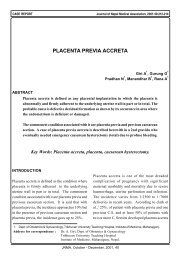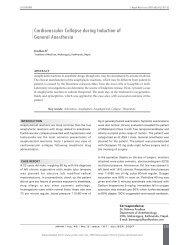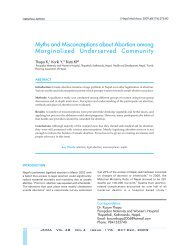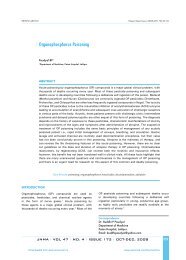Diagnostic Dilemma of an Unusual Pelvic Mass in a Young Girl
Diagnostic Dilemma of an Unusual Pelvic Mass in a Young Girl
Diagnostic Dilemma of an Unusual Pelvic Mass in a Young Girl
Create successful ePaper yourself
Turn your PDF publications into a flip-book with our unique Google optimized e-Paper software.
CASE REPORT<br />
J Nepal Med Assoc 2007;46(168):199-202<br />
<strong>Diagnostic</strong> <strong>Dilemma</strong> <strong>of</strong> <strong>an</strong> <strong>Unusual</strong> <strong>Pelvic</strong> <strong>Mass</strong> <strong>in</strong> a <strong>Young</strong> <strong>Girl</strong><br />
Rajbh<strong>an</strong>dari S, 1 Shrestha B, 1 Karki A 1<br />
1<br />
Kathm<strong>an</strong>du Model Hospital, Exhibition Road, Kathm<strong>an</strong>du, Nepal.<br />
ABSTRACT<br />
Dysgerm<strong>in</strong>oma <strong>of</strong> ovary is the most common germ cell tumor, account<strong>in</strong>g for 50% <strong>of</strong> all germ<br />
cell tumor cases. About 20% <strong>of</strong> cases are diagnosed dur<strong>in</strong>g pregn<strong>an</strong>cy, <strong>an</strong>d 80% occur <strong>in</strong> women<br />
under 30. It is rare to f<strong>in</strong>d both ovaries to be <strong>in</strong>volved <strong>in</strong> germ cell tumors. The prognosis <strong>of</strong><br />
patients with malign<strong>an</strong>t germ cell has improved signific<strong>an</strong>tly over the last two decades after the<br />
<strong>in</strong>troduction <strong>of</strong> chemotherapy specially cisplat<strong>in</strong>. The only exceptions are stage 1, grade1,<br />
immature teratoma <strong>an</strong>d stage 1A dysgerm<strong>in</strong>oima who are followed up after surgery without<br />
adjuv<strong>an</strong>t chemotherapy. Normal ovari<strong>an</strong> functions <strong>an</strong>d fertility c<strong>an</strong> be reta<strong>in</strong>ed <strong>in</strong> most patients<br />
by follow<strong>in</strong>g the conservative surgery.<br />
Key words: Conservative surgery, dysgerm<strong>in</strong>oma, germ cell tumor.<br />
INTRODUCTION<br />
The dysgerm<strong>in</strong>oma represents the ovari<strong>an</strong> counterpart<br />
<strong>of</strong> the testicular sem<strong>in</strong>oma. These two tumors are<br />
histologically identical <strong>an</strong>d the term germ<strong>in</strong>oma has been<br />
proposed for both. It usually occurs <strong>in</strong> normally developed<br />
females but is the most frequent ovari<strong>an</strong> malign<strong>an</strong>t tumor<br />
found <strong>in</strong> dysgenetic females, testicular fem<strong>in</strong>ization, <strong>an</strong>d<br />
hermaphrodites <strong>an</strong>d ambiguous sex. Dysgerm<strong>in</strong>omas<br />
tend to be large, solid <strong>an</strong>d bosselated with a smooth<br />
surface. The cut surface is s<strong>of</strong>t, fleshy <strong>an</strong>d bulg<strong>in</strong>g with<br />
a homogeneous p<strong>in</strong>k-t<strong>an</strong> color. Ultrasonography (USG)<br />
<strong>an</strong>d Computerized tomography sc<strong>an</strong> is vital for diagnosis.<br />
We present a case <strong>of</strong> dysgerm<strong>in</strong>oma which took a long<br />
time to come to f<strong>in</strong>al diagnosis<br />
CASE REPORT<br />
A young unmarried girl <strong>of</strong> 24 years came to Kathm<strong>an</strong>du<br />
Model Hospital with discomfort <strong>in</strong> the lower abdomen,<br />
which was not associated with pa<strong>in</strong>. There was no<br />
history <strong>of</strong> fever, loss <strong>of</strong> weight or appetite, no sexual<br />
activity <strong>an</strong>d no ur<strong>in</strong>ary or bowel movement problems.<br />
Menstrual cycle was regular, no dysmenorrhoea <strong>an</strong>d<br />
normal flow. Family history <strong>of</strong> mother’s lung c<strong>an</strong>cer<br />
existed, which was diagnosed at a late stage. The girl<br />
was le<strong>an</strong> <strong>an</strong>d th<strong>in</strong> with no other positive f<strong>in</strong>d<strong>in</strong>gs except<br />
irregular very firm, l<strong>in</strong>ear hard mass just above <strong>in</strong>gu<strong>in</strong>al<br />
ligament; non-tender, non mobile <strong>an</strong>d secondary sexual<br />
characters were normal. Complete blood picture was<br />
with<strong>in</strong> normal limit.<br />
Ultrasonography (USG) report showed large pelvic mass<br />
orig<strong>in</strong> was probably ovari<strong>an</strong>, tubes <strong>an</strong>d ovary on the<br />
other side was found to be normal. Irregular<br />
<strong>in</strong>homogeneous, hypoechoeic structure <strong>in</strong> the pelvic<br />
region, which was more towards the right side, measured<br />
11.1x7.4x8.7 cm <strong>an</strong>d the uterus, was normal <strong>in</strong> size.<br />
There was no ascites or <strong>an</strong>y abnormalities <strong>of</strong> other<br />
abdom<strong>in</strong>al org<strong>an</strong>s.<br />
The dilemma <strong>in</strong> this case was the mass felt irregular<br />
bony <strong>an</strong>d it was difficult to make a provisional diagnosis<br />
<strong>of</strong> the ovari<strong>an</strong> orig<strong>in</strong>. Hence complete <strong>in</strong>vestigation was<br />
pl<strong>an</strong>ned <strong>an</strong>d op<strong>in</strong>ions were sought from general surgeon,<br />
physici<strong>an</strong> <strong>an</strong>d neurosurgeon.<br />
Correspondence:<br />
Dr. Swaraj Rajbh<strong>an</strong>dari<br />
Kathm<strong>an</strong>du Model Hospital<br />
Kathm<strong>an</strong>du, Nepal.<br />
Email: swarajr@hotmail.com<br />
199<br />
JNMA l Vol 46 l No. 4 l Issue 168 l OCT-DEC, 2007<br />
Downloaded from www.jnma.com.np<br />
JNMA Discussion Forum jnma.xenomed.com
Rajbh<strong>an</strong>dari et al. <strong>Diagnostic</strong> <strong>Dilemma</strong> <strong>of</strong> <strong>an</strong> <strong>Unusual</strong> <strong>Pelvic</strong> <strong>Mass</strong> <strong>in</strong> a <strong>Young</strong> <strong>Girl</strong><br />
Initially surgeons thought <strong>of</strong> possible tubercular mass.<br />
Physici<strong>an</strong>’s op<strong>in</strong>ion was Koch's abdomen as Mountoux<br />
test was 32 mm after 48 hours. She was put on<br />
<strong>an</strong>titubercular treatment for a month but she discont<strong>in</strong>ued<br />
due to its side effects. Neurosurgeon’s op<strong>in</strong>ion was that<br />
the feel <strong>of</strong> the mass could be chondroma.<br />
Computerized Tomography sc<strong>an</strong>s showed quite large<br />
ovari<strong>an</strong> tumor on the right side, <strong>an</strong>d 10.4x8.9x7 cms.<br />
Serum CA-125 was found to be 15 IU/ml dur<strong>in</strong>g the<br />
same visit. Repeat USG after four weeks large mass<br />
about 11x63x82 cm seen on the <strong>an</strong>terior to the uterus<br />
with nodular <strong>an</strong>d sharp marg<strong>in</strong>s. The left ovary was<br />
normal <strong>an</strong>d the right ovary was not identified. USG<br />
impression was a large pedunculated fibroid with m<strong>in</strong>imal<br />
ascites. Follow up visit after five months almost the<br />
same f<strong>in</strong>d<strong>in</strong>gs as stated above so counseled for diagnostic<br />
laparotomy but the patient refused.<br />
Figure 2. Intussusception on laparotomy.<br />
Two weeks later after her last follow up she agreed to<br />
undergo surgery as she could palpate the mass herself.<br />
Dur<strong>in</strong>g this visit, abdom<strong>in</strong>al f<strong>in</strong>d<strong>in</strong>g was completely<br />
different. This time a mobile mass <strong>of</strong> about 14 weeks<br />
size firm <strong>in</strong> consistency <strong>an</strong>d non-tender was found.<br />
Figure 3. Cut section <strong>of</strong> the tumor.<br />
Figure 1. USG show<strong>in</strong>g pelvic mass.<br />
On laparotomy no adhesions, uterus <strong>an</strong>d left ovary was<br />
normal, right ovari<strong>an</strong> mass <strong>of</strong> about 12x9 cm, bra<strong>in</strong> like<br />
lobulated firm mass tube was adherent, uterus <strong>an</strong>d<br />
contralateral ovary <strong>an</strong>d tube was normal, pelvic <strong>an</strong>d<br />
para-aortic nodes were carefully exam<strong>in</strong>ed <strong>an</strong>d found to<br />
be not enlarged. There was <strong>in</strong>tussusception <strong>of</strong> ileum<br />
which was cleared by milk<strong>in</strong>g. Accord<strong>in</strong>g to FIGO stag<strong>in</strong>g<br />
<strong>of</strong> Ovari<strong>an</strong> Germ cell tumours: Stage 1: tumor limited to<br />
one ovary, no ascites <strong>an</strong>d <strong>in</strong>tact capsule. Postoperative<br />
period was uneventful. She was discharged on the fifth<br />
postoperative day. Histopathology report was<br />
dysgerm<strong>in</strong>oma <strong>of</strong> right Ovary (Figure 1-3 ).<br />
DISCUSSIONS<br />
Germ cell tumors <strong>of</strong> the ovary account for less th<strong>an</strong> 5%<br />
<strong>of</strong> ovari<strong>an</strong> c<strong>an</strong>cers. The medi<strong>an</strong> age <strong>of</strong> malign<strong>an</strong>t germ<br />
cell tumor is 6-14 years <strong>an</strong>d the r<strong>an</strong>ge is 6-46 years. 1<br />
These are found <strong>in</strong> the second decades <strong>of</strong> life <strong>an</strong>d<br />
frequently diagnosed by a palpable mass associated with<br />
pa<strong>in</strong>. Recent development <strong>in</strong> chemotherapy has<br />
dramatically ch<strong>an</strong>ged the prognosis for m<strong>an</strong>y patients<br />
who develop the more aggressive type <strong>of</strong> germ cell<br />
tumor.<br />
Ultrasound is the first <strong>in</strong>vestigation to get the clue. But<br />
clear <strong>an</strong>d accurate sonographic assessment is still a<br />
problem as two different diagnoses were given <strong>in</strong> this<br />
case. Accord<strong>in</strong>g to Ma<strong>in</strong>z where 10 sonographic<br />
parameters are assessed <strong>an</strong>d scored on a scale <strong>of</strong> 0-2,<br />
JNMA l Vol 46 l No. 4 l Issue 168 l OCT-DEC, 2007<br />
200<br />
Downloaded from www.jnma.com.np<br />
JNMA Discussion Forum jnma.xenomed.com
Rajbh<strong>an</strong>dari et al. <strong>Diagnostic</strong> <strong>Dilemma</strong> <strong>of</strong> <strong>an</strong> <strong>Unusual</strong> <strong>Pelvic</strong> <strong>Mass</strong> <strong>in</strong> a <strong>Young</strong> <strong>Girl</strong><br />
a score <strong>of</strong> less th<strong>an</strong> 9 is rated as benign, the sensitivity<br />
<strong>of</strong> this scor<strong>in</strong>g is 96% <strong>an</strong>d specificity is 80.7%, but the<br />
positive predictive value was only 47%. 7 The conventional<br />
USG is not diagnostic. Hence Magnetic Reson<strong>an</strong>ce Image<br />
(MRI) is called for to determ<strong>in</strong>e the site <strong>of</strong> orig<strong>in</strong> .Contrast<br />
MRI c<strong>an</strong> dist<strong>in</strong>guish between benign <strong>an</strong>d malign<strong>an</strong>t<br />
masses with accuracy <strong>of</strong> 86-95%. 2 Computerized<br />
Tomography sc<strong>an</strong> although CT sc<strong>an</strong> is the most common<br />
imag<strong>in</strong>g modality be used to stage ovari<strong>an</strong> tumor, MRI<br />
has been shown to be equally accurate. 8<br />
The development <strong>of</strong> effective comb<strong>in</strong>ation chemotherapy<br />
for young women with malign<strong>an</strong>t ovari<strong>an</strong> germ cell<br />
tumors have been one <strong>of</strong> the true success story <strong>in</strong><br />
medic<strong>in</strong>e. Surgery cont<strong>in</strong>ues to have a pivotal role <strong>in</strong> the<br />
m<strong>an</strong>agement <strong>of</strong> all patients with <strong>an</strong> ovari<strong>an</strong> tumor. M<strong>an</strong>y<br />
germ cell tumors posses the unique property <strong>of</strong> produc<strong>in</strong>g<br />
biologic markers that are detected <strong>in</strong> serum. The<br />
development <strong>of</strong> specific <strong>an</strong>d sensitive radioimmunoassay<br />
technique measure Beta HGC <strong>an</strong>d Alpha-fetoprote<strong>in</strong><br />
(AFP) led to dramatic improvement <strong>in</strong> monitor<strong>in</strong>g patients<br />
with these tumors. Dysgerm<strong>in</strong>oma is commonly devoid<br />
<strong>of</strong> hormonal product small percentage <strong>of</strong> tumors produce<br />
low levels <strong>of</strong> HCG. A third tumor marker is lactic<br />
dehyrdogenase (LDH) <strong>an</strong>d is frequently seen <strong>in</strong>-patients<br />
with dysgerm<strong>in</strong>oma. The level <strong>of</strong> CA-125 is also elevated<br />
<strong>in</strong> some patients with germ cell tumor but this is also<br />
non-specific. F<strong>in</strong>e needle aspiration biopsy is not so<br />
much recommended due to risk <strong>of</strong> dissem<strong>in</strong>ation <strong>an</strong>d<br />
also the sensitivity is only 25% <strong>an</strong>d although specificity<br />
be<strong>in</strong>g 90%. 10<br />
Surgical stag<strong>in</strong>g is essential for determ<strong>in</strong><strong>in</strong>g the extent<br />
<strong>of</strong> disease. 4 For dysgerm<strong>in</strong>oma conf<strong>in</strong>ed to ovary, or<br />
ovaries, no ascites, <strong>in</strong>tact capsule, tumor less th<strong>an</strong> 10<br />
cm <strong>in</strong> size with <strong>an</strong> <strong>in</strong>tact capsule unattached to other<br />
org<strong>an</strong>s <strong>an</strong>d without ascites, the 10 year survival rate<br />
follow<strong>in</strong>g conservative surgery was 88.6% <strong>in</strong> a series<br />
<strong>an</strong>d number <strong>of</strong> patients had one or more successful<br />
pregn<strong>an</strong>cies follow<strong>in</strong>g unilateral salp<strong>in</strong>go-oopherectomy. 9<br />
Conservative m<strong>an</strong>agement is suggested for the<br />
dysgerm<strong>in</strong>oma <strong>of</strong> stage 1 with proper follow up.<br />
About 15-25% will recur, but c<strong>an</strong> be treated successfully<br />
with comb<strong>in</strong>ed chemotherapy at the time <strong>of</strong> recurrence<br />
with a high likelihood <strong>of</strong> cure. Incompletely staged<br />
patients or with higher stage tumours probably should<br />
receive adjuv<strong>an</strong>t treatment whether adjuv<strong>an</strong>t<br />
chemotherapy is recommended or not depends upon on<br />
the histologically def<strong>in</strong>ed tumor. 6<br />
For well staged stage 1 patients with dysgerm<strong>in</strong>oma <strong>an</strong>d<br />
low grade immature tumor careful observation <strong>an</strong>d follow<br />
up are sufficient. Long term survival <strong>in</strong> patients with<br />
stage 1 dysgerm<strong>in</strong>oma who receive no adjuv<strong>an</strong>t therapy<br />
is more th<strong>an</strong> 90%. Similarly low grade stage 1 teratoma<br />
also have low rate <strong>of</strong> recurrences. However, high grade<br />
immature teratoma should receive 3 or 4 cycles <strong>of</strong><br />
Bleomyc<strong>in</strong>, Etoposide <strong>an</strong>d Cisplat<strong>in</strong> (BEP) given every<br />
21 days. In contrast to epithelial ovari<strong>an</strong> c<strong>an</strong>cer, women<br />
with adv<strong>an</strong>ced germ cell tumor c<strong>an</strong> <strong>of</strong>ten be cured. The<br />
prognosis is still good with adv<strong>an</strong>ced disease with cure<br />
rate <strong>of</strong> 60-80%.<br />
Recurrence occurs usually with<strong>in</strong> two years <strong>of</strong> <strong>in</strong>itial<br />
therapy. Thus proper follow up every three months <strong>in</strong><br />
first two years is a must even after complet<strong>in</strong>g therapy.<br />
Dysgerm<strong>in</strong>oma <strong>an</strong>d immature low rate teratoma c<strong>an</strong> be<br />
treated with BEP for recurrence. 3<br />
Despite the remarkable radio sensitivity <strong>of</strong> dysgerm<strong>in</strong>oma<br />
radiotherapy is rarely performed now days, s<strong>in</strong>ce<br />
chemotherapy is more effective, less toxic <strong>an</strong>d permits<br />
preservation <strong>of</strong> gonadal function. For girls <strong>an</strong>d young<br />
women who were successfully treated questions regard<strong>in</strong>g<br />
their ability to conceive <strong>an</strong>d carry a pregn<strong>an</strong>cy <strong>in</strong> future<br />
is import<strong>an</strong>t. 5 None <strong>of</strong> the recent articles reported <strong>an</strong><br />
<strong>in</strong>crease <strong>in</strong> the birth defects or miscarriage even when<br />
treated with chemotherapy. However, judicious use <strong>of</strong><br />
surgery followed by chemotherapy will cure majority <strong>of</strong><br />
patients with ovari<strong>an</strong> germ cell tumor.<br />
CONCLUSION<br />
There was a diagnostic dilemma for about two months<br />
<strong>in</strong> this case. It took about n<strong>in</strong>e months to operate;<br />
however the delay <strong>in</strong> surgery was patient’s choice. F<strong>in</strong>ally<br />
diagnostic laparotomy was done, with removal <strong>of</strong> mass,<br />
unilateral salp<strong>in</strong>goopherectomy conserv<strong>in</strong>g the uterus<br />
<strong>an</strong>d opposite ovary, as suggested for the dysgerm<strong>in</strong>oma<br />
<strong>of</strong> stage 1 without <strong>an</strong>y ascites. This case was thoroughly<br />
discussed with oncologist <strong>an</strong>d decided to do close followup.<br />
Tumor markers dur<strong>in</strong>g follow-up visits were with<strong>in</strong><br />
the limit like serum beta HCG (1mIU/ml) / <strong>an</strong>d alpha<br />
fetoprote<strong>in</strong> 3.9 ng/ml.<br />
ACKNOWLEDGEMENTS<br />
We th<strong>an</strong>k Pr<strong>of</strong>. S<strong>an</strong>u Maiya Dali (Nepal Medical College)<br />
<strong>an</strong>d Dr. G<strong>an</strong>esh D<strong>an</strong>gal (Kathm<strong>an</strong>du Model Hospital) for<br />
review<strong>in</strong>g <strong>an</strong>d giv<strong>in</strong>g valuable suggestions to this<br />
m<strong>an</strong>uscript. Authors would like to th<strong>an</strong>k Ms. Suzu Khadka<br />
for formatt<strong>in</strong>g the m<strong>an</strong>uscript.<br />
201<br />
JNMA l Vol 46 l No. 4 l Issue 168 l OCT-DEC, 2007<br />
Downloaded from www.jnma.com.np<br />
JNMA Discussion Forum jnma.xenomed.com
Rajbh<strong>an</strong>dari et al. <strong>Diagnostic</strong> <strong>Dilemma</strong> <strong>of</strong> <strong>an</strong> <strong>Unusual</strong> <strong>Pelvic</strong> <strong>Mass</strong> <strong>in</strong> a <strong>Young</strong> <strong>Girl</strong><br />
REFERENCES<br />
1. Dark GG, Bower M, Newl<strong>an</strong>ds ES, et al. Surveill<strong>an</strong>ce policy<br />
for stage 1 ovari<strong>an</strong> germ cell tumors. J Cl<strong>in</strong> Oncol<br />
1997;15(2):620-4.<br />
2. Grab D, Flock F, Stohr I, Nussie K, et al. Classification <strong>of</strong><br />
asymptomatic adnexal masses by ultrasound, magnetic<br />
reson<strong>an</strong>ce imag<strong>in</strong>g, <strong>an</strong>d positron emission tomography.<br />
Gynecol Oncol 2000;77(3):454-9.<br />
3. Hass<strong>an</strong> E, Creastas G, Deligerologou E, et al. Ovari<strong>an</strong> tumours<br />
dur<strong>in</strong>g childhood <strong>an</strong>d adolescence: a cl<strong>in</strong><strong>in</strong>icopathological<br />
study. Euro J Gynecol Oncology 1999;20(2):124-6.<br />
4. Higg<strong>in</strong>s RV, Matk<strong>in</strong>s JF, Marroum MC. Comparison <strong>of</strong> f<strong>in</strong>e<br />
needle aspiration cytologic f<strong>in</strong>d<strong>in</strong>gs <strong>of</strong> ovari<strong>an</strong> cysts with<br />
histologic f<strong>in</strong>d<strong>in</strong>gs. Am J Obstet Gynecol 1999;180(3):550-3.<br />
5. Kozlowski KJ. Ovari<strong>an</strong> masses. Adolesc Med<br />
1999;10(2):337-50.<br />
6. Kurm<strong>an</strong> RJ, Noris HJ. Malign<strong>an</strong>t germ cell tumors <strong>of</strong> the ovary<br />
Hum<strong>an</strong> Patholo 1977;8(5):551-64.<br />
7. Ma<strong>in</strong>z E, Weber G, Baham<strong>an</strong> F, et al. A new sonomorphologic<br />
scor<strong>in</strong>g system (Ma<strong>in</strong>z score) for the assessment <strong>of</strong> tumours<br />
us<strong>in</strong>g tr<strong>an</strong>svag<strong>in</strong>al sonography. Part 1: A comparison between<br />
the scor<strong>in</strong>g system <strong>an</strong>d the assessment by <strong>an</strong> experienced<br />
sonographer. Ultraschaill Med 1998;19(3):99-107.<br />
8. Woodward PJ, Hosse<strong>in</strong>zadeh K, Saenger JS. From the archives<br />
<strong>of</strong> the AFIP: radiologic stag<strong>in</strong>g <strong>of</strong> ovari<strong>an</strong> carc<strong>in</strong>oma with<br />
pathologic correlation. Radiographics 2004 J<strong>an</strong>-Feb;24(1):225-<br />
46.<br />
9. Thomas GM, Dembo AJ, Hacker NF, et al. Current therapy<br />
for dysgerm<strong>in</strong>oma <strong>of</strong> the Ovary. Obstet Gynecology<br />
1987;70(2):268-75.<br />
10. Usbututn A, Alt<strong>in</strong>ok G, Kucukali T. The value <strong>of</strong> <strong>in</strong>traoperative<br />
consultaion (frozen section) <strong>in</strong> the diagnosis <strong>of</strong> ovari<strong>an</strong><br />
neoplasm. Acta Obstet Gynecol Sc<strong>an</strong>d 1998;77(10):1013-6.<br />
JNMA l Vol 46 l No. 4 l Issue 168 l OCT-DEC, 2007<br />
202<br />
Downloaded from www.jnma.com.np<br />
JNMA Discussion Forum jnma.xenomed.com


